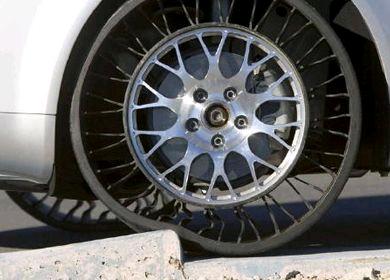Pneumatic tires are a horrible nuisance when they are worn out. Some can be recapped, which means that if the casing is still intact and solid, a new tread of rubber can be fused back where the old tread used to be. This is often done with truck and other large tires. However, the presence of long pieces of tread rubber on the highway shows that the fusion attachment method is not always reliable.
Some people have proposed ways to shred the rubber that is left turning it into what they call “crumb rubber”. That can be mixed with asphalt to make roads more flexible. Sometimes it is incorporated right into new rubber as an additive. Some people have gotten patents on ways to freeze the tires until they are so hard that they can be shredded by cracking and grinding.The consumption of excess energy for freezing is obvious.
But all of these methods are beside the point. There is no universal way to modify a used tire and send it back into service. These downstream methods may use up some materials but the torrent of used tires is way greater than any of these desperately inadequate recycling methods (retreading would be fine if it were universal). (See this proposal for destruction). Reusing for the original purpose is the best reuse method because then the number of used up articles is exquisitely matched to the number of new articles wanted.
The heartbreaking fact of life with tires is that they are traditionally discarded into huge piles which routinely catch on fire, burning for weeks, months or years. When put into a dump, their physical properties cause them to work their way up to the top so they don’t even stay buried which causes consternation among the dumpers.
So what can be done? The design is fine-tuned for critical driving and seems to leave no room for a new design. That is why a radically new design by Michelin, for an all solid rubber tire with no air, is very satisfying from a Zero Waste point of view.

Michelin’s tire has a central drum with radial leaves that connect to an outer drum that actually contacts the road. They make all manner of claims for it but for our purposes the significance is that there are ways to change the design of the car tire which might have a better reuse and refurbishing potential.
For example, could the radial leaves slide into slots in the two drums instead of being cast as part of the drums? Could they be held in place with fasteners that are so reliable that the leaves can never pop out until a leaf tears or abrades and needs to be replaced. Then maybe a tow truck with a box of different sized leaves could jack up the car, slide out the old leaf and slide in a new one. Just a thought. Michelin probably never even thought about this aspect of their design.
The pneumatic design is not cast in stone. It is too early to suggest actual reuse methods but at least there is movement on the frontier of tire design.
Would you like to see four or five brand new designs including some derivatives of that airless tire pictured above? Click on: http://www.ba-bamail.com/video.aspx?emailid=32678 . As the sophisticated reader of these articles will immediately realize, none of these amazing designs are connected in any way with reuse, or repair, or Zero Waste in any sense. In the minds of the engineers, they will be made, used up, and thrown into a dump, just like the common pneumatic tires are. But this shows how the march of new technology provides ample room for increasing the reusability of new devices at the same time as the functions are being improved.
Here are some new designs which also show that different designs are possible: Go to Youtube
Aside from the Zero Waste aspects of pneumatic tires, think about where all that rubber goes. Clearly, by rubbing against roadways, the rubber turns into tiny particles of rubber which fly around in the air so we can breathe it. It runs into waterways to remain suspended and be eaten by fish. It settles on growing food for us to eat. Common sense tells us this is happening. Is the rubber destroyed in the environment into small molecules by oxygen and UV light before it can settle as a pollutant? Something tells me the tire companies have studied this question but I don’t think they are talking. This is still one more reason to find some way to replace pneumatic tires with a more advanced (and reusable) design.
